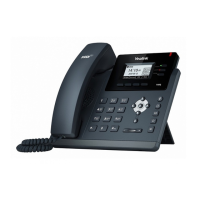Administrator’s Guide for SIP-T2 Series/T4 Series/T5 Series IP Phones
296
It configures the port of emergency server X to be used for routing calls.
Note: It works only if “dialplan.emergency.enable” is set to 1 (Enabled) and
“dialplan.emergency.asserted_id_source” is not set to HELD.
dialplan.emergency.server.X.transport_type
[1]
It configures the transport protocol the IP phone uses to communicate with the
emergency server X.
Note: It works only if “dialplan.emergency.enable” is set to 1 (Enabled) and
“dialplan.emergency.asserted_id_source” is not set to HELD.
0-UDP
1-TCP
2-TLS
3-DNS-NAPTR
dialplan.emergency.X.value
[2]
It configures the emergency number to use on your IP phone so a caller can contact
emergency services in the local area when required.
Note: It works only if “dialplan.emergency.enable” is set to 1 (Enabled) and
“dialplan.emergency.asserted_id_source” is not set to HELD.
When X = 1, the default value is 911;
When X = 2-255, the default value is Blank.
dialplan.emergency.X.server_priority
[2]
It configures the priority of which the emergency servers to be used first.
Multiple values are separated by commas. The servers to be used in the order listed
(left to right).
The IP phone tries to make emergency calls using the emergency server with higher
priority, and then with lower priority. The IP phone tries to send the INVITE request to
each emergency server three times.
Note: If the account information has been configured (no matter whether the account
registration succeeds or fails), the emergency calls will be dialed using the following
priority: SIP server>emergency server; if not, the emergency server will be used. It
works only if “dialplan.emergency.enable” is set to 1 (Enabled) and

